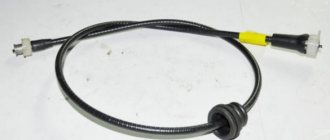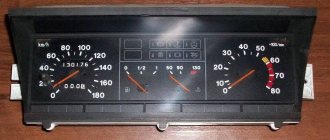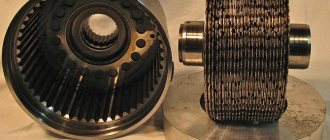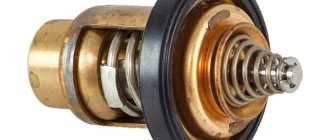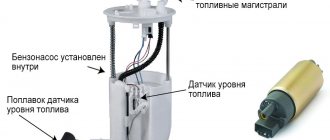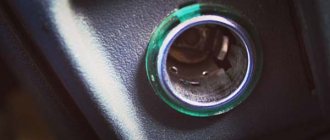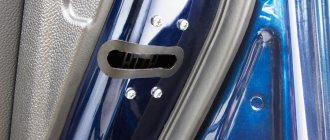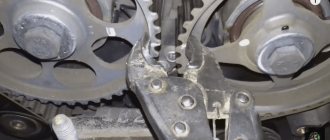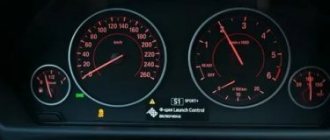Car odometer: what is it?
The dashboard of a modern car, of course, cannot be compared with the dashboard of an airplane, however, it can confuse an inexperienced driver. The speedometer, tachometer, odometer and other instruments and indicators, while certainly necessary and important, still require an explanation of their functions and their purpose. In this article we will talk about what a car odometer is, what they are, and also say a few words about how and why the readings of these devices are distorted.
Why do you need an odometer in a car?
The main task of the odometer is to show the total mileage of the car. This figure is important when buying or selling a vehicle.
On the dashboard you can see not one, but two odometers - one counts the total mileage, and the second - the daily mileage. The total cannot be reset, but the daily allowance can be reset very easily.
Many novice motorists ask a lot of questions about why even count the number of kilometers traveled by a car. Is this meaning really that important?
Odometer readings are used in the following cases:
- When buying or selling a car. The numbers on the instrument panel will tell you about the technical condition of the car’s chassis and engine;
- Fuel consumption. If you reset the readings on the daily odometer and fill up a full tank of gasoline or a full cylinder of gas, the driver can accurately determine the car’s appetite for 100 km;
- The distance between populated areas or any other points.
The daily odometer readings are useful for those who drive on second-generation gas - this is how and only this way you can determine the amount of gas in the cylinder. Also, the numbers will be important for those who earn money from car mileage.
If the device does not work
Incorrect operation or complete failure of the odometer does not affect the technical condition of the car in any way. However, it entails a lot of problems for the car owner, because... If the odometer fails, it becomes almost impossible to:
- objectively assess mileage on long trips;
- make timely decisions on refueling along the way;
- correctly determine the timing of the next maintenance;
- avoid “inconvenient” questions and suspicions of fraud when selling a car.
Strictly speaking, the fact of operating a vehicle with non-functioning sensors on the instrument panel as an indicator of the driver’s frivolous attitude towards the maintenance of his car is unacceptable!
Causes of breakdown and repair
The reasons for the failure of the odometer depend on the type of meter, the most reliable of which is electronic as part of the on-board computer.
- The mechanical odometer may stop working due to:
- normal wear and tear;
- car accident;
- interference with work in order to correct instrument readings (twisting)
- An electronic-mechanical odometer may “break” due to:
- violation of contacts between the meter and the wheel sensor;
- chip failure on the dashboard.
- Failure of an electronic device most often occurs as a result of manipulations to twist the mileage readings.
Knowing the possible causes of odometer failure, you can independently eliminate almost all malfunctions on the first two types of meters. Repairing an electronic device will require the intervention of an electronics specialist.
What is a speedometer
A speedometer is a device that measures the instantaneous speed of a vehicle. The meter readings are displayed in km/h (kilometers per hour) or - in America - miles per hour. There are two types of speedometers: mechanical (analog), digital. How does the speedometer work and what does it show? In a rear-wheel drive car, the speedometer controls the rotation of the secondary shaft at the gearbox, in this case the speed is calculated from it. Accordingly, the speed readings will depend on the tire size, the gear ratio of the rear axle, as well as the device’s own error. For front-wheel drive vehicles, speed is measured using the left wheel drive. The curvature of the road adds to the speedometer error. We looked at the odometer and speedometer above (the difference is what they are used for, principles of operation). Let us now find out the reasons for speedometer errors.
Digital.
What is an odometer in a car, the differences between the device and the speedometer
The digital speedometer was developed as recently as 1993.
The digital speedometer indicator is a liquid crystal or analog display that displays speed in digital format.
In the second case (analog display), there is a problem with the delay of readings: if there is no delay in displaying speed values or the delay is too small, the driver is not able to correctly perceive the numbers constantly “running” before his eyes; if you introduce a significant delay, the indicator begins to incorrectly display data on the instantaneous braking and acceleration speed.
In this regard, analog indicators are widely used, and digital indicators are used on a relatively small number of models; The peak of popularity occurred in the 1970-80s in the USA, from where Japanese manufacturers picked up this fashion, but later on most models they decided to change them to the traditional arrow version.
Why is the speedometer lying?
If you look at a car's speedometer, it's not hard to guess why it's lying. Why does it show the speed limit? Firstly, the driver has less chance of breaking the speed limit and getting a fine. Secondly, if the speedometer indicated a lower speed than the real one, then, most likely, drivers would not stop suing automakers, proving their innocence of speeding. Does the speedometer have to lie? The fact is that this device is the most difficult to provide super-accurate readings, because the speed depends on the rotation of the wheel, on its diameter, and this is a very unstable parameter.
The speedometer error at a speed of 60 km/h is very minimal, it is practically non-existent. At a speed of 110 km/h, the error may be 5-10 km/h. If a car reaches a speed of up to 200 km/h, then the average error can be up to 10%. We have answered your question “what are odometer and speedometer”. The difference is now clear. Let's summarize. All of the above makes it possible to draw the following conclusions.
Instrument errors
Even the electronic odometer has inaccuracies.
They cannot be excluded, therefore it is customary to take into account certain standards that allow a limit to this value. For example, on a mechanical device the error should not exceed 5% -15%. Device errors are explained by the presence of various gaps, weakness of the cable, poor grip and weak springs. A mechanical odometer produces more errors, a digital one produces much less, because it is possible to read the readings of a microcontroller and sensor.
There may also be an error on the speedometer, which calculates the speed of the car. The device is simply unable to display perfectly accurate information, since the speed depends on several components: rotation of the wheel, its diameter, etc.
It will be interesting to monitor the errors of the device at different speed modes.
- 60 km/h - there are almost no errors.
- 110 km/h - the error is 5-10 km/h.
- 200 km/h - the average value reaches 10%.
The error also varies according to the following points.
On cars with front-wheel drive, the error appears at almost every turn. The reason is that the speedometer is integrated with one wheel. Because of this, turning to the left reduces the readings, turning to the right increases them. The error is affected by non-standard wheel size
A difference of 1 cm increases the error to 2.5%. The diameter of the tire is important. At the slightest discrepancy with the standard, the speedometer readings are underestimated or overestimated. Tire pressure and tread wear can affect the error.
For example, if the tire is poorly inflated, this leads to an underestimation of the maximum speed.
The most accurate readings are given, as mentioned, only by a digital device or a device connected to a GPS navigator. The benefits of satellite positioning cannot be underestimated. Modern systems demonstrate the exact speed of the vehicle without any errors.
The standard speedometer is marked with a scale of 10 km/h, and its needle twitches on potholes. He can only overestimate the readings, but not underestimate. Otherwise, the road situation will be falsely assessed and an emergency situation will arise. For example, if 100 km/h is displayed instead of the real 120 km/h.
A few words about errors associated with tire sizes. This is where the design of the speedometer itself comes into play. It consists of two devices combined in a single housing. One device measures speed, the other shows the vehicle's mileage. So they are called: high-speed and counting nodes.
Now specifically: if the car is shod with tires that are quite worn, the speedometer will overestimate the readings, since the gradation system comes into force every 10 km/h and the law of rounding numbers used in odometers.
How does an odometer work on a car?
What does a mechanical odometer look like on the dashboard?
There are only three types of odometers:
- mechanical;
- electronic-mechanical;
- electronic;
Mechanical odometers are more than simple. There is a cable that connects to the output shaft of the gearbox, there is a mechanical counter with several, usually five, drums, to which the rotation of the cable is transmitted through a special mechanism. The reels are marked with numbers from which the odometer readings are compiled.
In electronic-mechanical odometers, the rotation of the cable is recorded using an electronic counter. Well, in purely electronic odometers there is no cable at all. Instead, Hall sensors or other electronic components are used to calculate the distance. Moreover, in the case of an electronic odometer, the readings are recorded by the on-board computer of the car. Such systems are considered the most accurate and reliable, but even they allow a measurement error of as much as five percent.
What does an electronic odometer look like on the dashboard?
The reasons for the distortion of odometer readings may be different. For example, this is wheels slipping when they rotate, but the car stands still. And although such moments make up a tiny part of the overall performance of the car, with high mileage values, they can contribute to distortion of the odometer readings.
Another reason for inaccuracies in the readings of such devices is tires with a size different from the one for which the odometer is designed.
Well, perhaps the most important reason for distortions in a car’s mileage may be intentional corrections of the odometer readings , and we’ll talk about them.
Design and principle of operation
It is common to think that the odometer can count kilometers traveled. In fact, the device measures the number of revolutions of the car's wheels as it moves. Probably everyone could observe different mileage at the same distance, but with different wheel diameters.
The odometer is designed as follows:
- Mechanical counter or electronic display - elements allow you to read data from the instrument panel;
- A counter or sensor that counts wheel revolutions;
- A controller inside of which, according to special algorithms, wheel revolutions turn into kilometers.
The device itself can be mechanical or electronic. The wheel can make an exact number of revolutions for every kilometer. Moreover, this indicator will be the same under different conditions. If the device knows exactly the number of revolutions per kilometer, then it is quite capable of calculating the distance traveled.
The mechanical odometer is driven by a flexible cable - it is made of a tightly coiled spring. Often, the cable is located inside a metal tube, which, in turn, is located in a rubber casing.
To operate the mechanism, the cable is connected on one side to the output shaft of the gearbox, and on the other side to the dashboard. There the cable is connected to the input shaft at the odometer.
Several worm gears are used inside the mechanical device. In general, the gear ratio is 1690:1.
The input cable causes the first worm gear to rotate - one revolution can turn the gear only one tooth. The same mechanism causes the next gear to rotate, which drives the next one.
Each mechanical type indicator has a row of pins that stick out from one side. There is also a set of two pins that are sharpened from the arc side.
When two pins are connected to a gear, one tooth is caught between the pins and can rotate with the indicator until the pins move further. In this mechanism, one of the pins also works, there are a larger number and performs 1/10 of the love spell.
Now, it’s probably clear and understandable why when the odometer shows between 19,999 and 20,000, the number “2” is somewhere in the middle, and not on a common level with the other numbers. The fact is that the device uses small pins that prevent the entire digital row from being in the same position. Often, for this reason. In order for all the numbers to be in an even row, the device must show 21,000.
As for electronic odometers of modern cars, everything is much more complicated. Everyone had or has a bicycle with a computer. So, a magnet is attached to the wheel of such a bicycle, and a reed switch is attached to a fixed part, for example, on a fork. When the magnet passes near the reed switch, the computer counts the rotation of the wheel, and then the information on the display is updated.
The car uses a system similar to a bicycle. Of course, the car owner will not find a magnetic sensor on the wheel - instead, you can see a toothed gear on the output shaft of the gearbox. A special sensor counts pulses when a gear tooth passes by it.
In some car models you can see a slot wheel and optical sensors - such an implementation is found in a computer mouse. The car's computer knows how far the car will travel between pulses and updates the odometer based on these numbers.
One of the interesting things about the modern odometer has to do with how the mileage data gets displayed on the instrument panel. The cable that was in the mechanical sensor is not here at all. The instrument panel receives information from the ECU through electronic circuits.
In this case, the car can be compared to a local network. Most machines use standard communication protocols - for example, SAE J1850. Thanks to them, all electronic systems and devices in the car can communicate and exchange data between devices.
The car's ECU takes into account each impulse and monitors the total distance the car has traveled during its life.
There is an opinion among experts that it is more difficult to sell a car with an electronic odometer - it is difficult to twist it back. It is easy to change the numbers on the dashboard, but it is very difficult to deceive the ECU, gearbox unit or other systems.
The role of durability in determining the mileage of a used car
Errors in odometer measurements during vehicle operation are often explained by objective reasons: wear and tear of the vehicle and individual components, harsh operating conditions, etc. Depending on the type of odometer, normal error indicators can vary between 5-10%, in the case of a mechanical type of device - up to 15%. Elimination of natural causes of distortion of results can reduce the percentage of errors in the operation of the odometer. However, this does not always coincide with the interests of car owners.
ATTENTION! Often the reason for distortion of the device readings is a deliberate adjustment of the total mileage of the car in one direction or another.
Most often - in the direction of reducing them when it comes to pre-sale preparation of a used car.
Thousands of kilometers driven on the odometer indicator is the main indicator of the technical condition of a car: the greater the mileage, the higher the degree of wear of its components and components; This means the selling price is lower.
The procedure for “rejuvenating” a worn-out car by significantly reducing its mileage is commonly called “speedometer twisting” or “rewinding.” Despite the dubious legality of this approach, special equipment and computer programs exist and are offered on the service market today, promising to adjust the mileage of any type of odometer.
The easiest way is to “rewind the mechanics”; digital devices require special equipment and an experienced specialist who can reprogram several on-board controllers.
Experienced car enthusiasts advise diagnosing a used car for “twisting”: readings from magnetic wheel sensors are transmitted not only to the odometer, but also to other functional components of the car, which means they can be restored.
Even a small test drive, according to experienced drivers, can reveal manipulations with on-board equipment. Jumping readings on the odometer indicators during a test drive will indicate interference with the operation of the device; will save the buyer from a rash step.
What does the odometer measure?
Electronic odometer on the dashboard. Below is the total mileage, at the top is the daily mileage, on the right is a button to reset the daily mileage.
If the speedometer measures the speed at which the car is currently moving, then the odometer shows the number of kilometers the car has traveled. Translated from Greek, odo means road, and meter means to measure. So in the end we get a kind of “road meter”.
The odometer counts the kilometers traveled by counting the number of wheel rotations. Typically this device has two types of readings. The total mileage of the car, here we count every kilometer traveled by the car from the moment it left the assembly line, as well as the so-called daily mileage. It is called a daily allowance rather arbitrarily. In essence, you press a button, reset the readings of this scale, after which you can see the mileage of any segment of the route that you have covered over a period of time. Well, this figure is usually called the daily rate by taxi drivers, which is where the name comes from.
Indication error
The odometer is not an accurate measuring instrument. It has errors, just like the speedometer. Today there are entire standards for these same errors. It is believed that a mechanical odometer has an error of 5% to 15%.
If the car is operated mostly in harsh conditions, then the errors may be larger.
It must be taken into account that the sensor counts wheel revolutions, which means that the error increases due to wear of components and mechanisms, wear of tires and other systems. Slipping also affects the error - the car does not move, but the odometer counts.
The readings can be affected by gaps, loose springs, and poor grip. The electromechanical system reads the signals that the ECU sends in one unit of time.
In this case, the percentage of error will be negligible. But on average, the error of an electromechanical device is more than 5%, and the error of an electronic odometer is less than 5%.
Reading accuracy
Any odometer, even if standard wheels are used, has an error. This is allowed because for the mileage of a car, meters do not play as much of a role as kilometers.
And maintenance of a car is generally carried out after a certain number of thousands of kilometers. For this reason, the error of the mechanisms (and even the electronic analogue) can range from two to ten percent. The device also records the number of kilometers, not centimeters or meters.
In addition to the factory error, in a car with high mileage, the device can give even less accurate readings. This is due to wear of parts or failure of the sensor.
Device types
At the dawn of the development of the automotive industry, only mechanical odometers were installed on cars. With the development of electronics, starting from the middle of the last century, electronic-mechanical devices appeared. On modern cars, mainly electronic odometers are installed and they are displayed on the dashboard, as a rule, in the form of a separate display.
Mechanical
The simplest to manufacture and most reliable mechanical devices. In them, mileage calculation was carried out by transmitting the rotations of a gear installed on the secondary shaft of the gearbox (its speed corresponds to the speed of rotation of the wheels) through a special cable to a roller with a set of numbers in the speedometer block. A significant drawback of such an odometer was that at some point the numbers ran out and it was reset to zero. It was impossible to determine the total mileage of the car, unless, of course, to record the number of “zeros.” And if he wanted to twist his testimony, it was also not difficult for an unscrupulous owner. These devices also suffered from inaccurate readings, which directly depended on the diameter of the wheels used - it had to be strictly calculated.
Semi-electronic
It was precisely in order to establish a record of the total mileage of a vehicle and to complicate the possibility of “twisting” the readings that semi-electronic odometers were developed. In them, the mechanical rotations of the same cable are converted by an induction unit into electromagnetic signals, which are then read by an electronic display and an on-board computer, in which all the data is stored. In such devices, it is already more difficult to change the readings, because you need to rewrite the records of the storage medium, but, unfortunately, there are already skilled people for such unjust deeds. Moreover, many websites have been created on the Internet, such as “odometer.rf,” offering such services, advertising such an operation as very simple. Although this is not true, because to get to the mileage records on all electronic units, in addition to skill, you will also need a significant amount of time.
Electronic
More advanced odometers are electronic. In them, the mechanical parts are replaced with Hall sensors, which convert the rotation of the secondary shaft into electromagnetic pulses, which are then read by electronic devices. Their readings are the most correct, they are distributed and stored in different electronic units of the car, so getting to them to change records is even more difficult.
Deep into history
The oldest odometer is mentioned in the first century. The Greek mathematician Heron became the father of this invention. The device was in the form of an ordinary cart, the wheels of which were selected with a special diameter. The wheels turned exactly 400 times in 1598 meters (milliatri). A gear drive set the simplest mechanism in motion. The mileage was indicated by small stones that fell into the tray. To calculate the distance traveled, it was necessary to count the number of stones that fell. Since then, people have stepped far forward in their inventions, but the idea itself was ideal.
The speedometer and odometer, the difference between which is not only in the readings, also have different dates of invention. The speedometer was invented just over a hundred years ago. The first such device was installed on an Oldsmobile car in 1901. For ten years, the speedometer was only an optional extra and was considered a curiosity. Later, factories began to install it as a mandatory device. In 1916, the speedometer underwent improvements by Nikola Tesla. It has survived to this day in almost the same condition, apart from some modern additions.
Why do they rewind the odometer readings, how is it done?
When buying a used car, people are primarily interested not so much in the year of manufacture as in its mileage. No one wants to purchase a heavily used vehicle, such as in a taxi.
Therefore, some enterprising car enthusiasts rewind the odometer readings in the opposite direction in order to sell the car at a higher price. Sometimes the odometer readings are also “twisted” on a company car that has been used for other purposes.
“Rewinding” the readings occurs using a computer, in more rare cases – mechanically (on older car models).
Twisting odometer readings is a real business that has been successfully operating and developing for a long time. Even on YouTube you can find many tutorials and videos explaining the twisting process for various odometers.
Very often, the service of rewinding the distance counter of cars is modestly called “mileage correction.” Thus, sellers protect themselves from law enforcement agencies. After all, the service is illegal.
By the way, when buying fairly old cars, almost all buyers understand that the readings of the so-called mileage counter in the car have been twisted. Of course, this is taken into account when bidding.
By measurement method:
Centrifugal
– the arm of the regulator, which is held by a spring, rotates together with the spindle and is tilted to the sides by centrifugal force so that the displacement is directly proportional to the speed.
Chronometric
– a combination of a clock mechanism and an odometer.
Induction
- a system of permanent magnets rotating with the drive spindle generates eddy currents in a copper or aluminum disk placed in a magnetic field. The disk is thus drawn into a circular motion, but its rotation is slowed down by a limiting spring. The disk is connected to an arrow indicating speed.
Electromagnetic
— the speed is determined by the EMF generated by the tachogenerator connected to the spindle.
Vibrating
– applicable for high-speed rotating machines. The mechanical resonance of the vibrations of the bearings or the machine frame causes the graduated reeds to vibrate at a frequency corresponding to the number of revolutions of the machine.
By satellite positioning system
— speed is determined electronically by the GPS satellite positioning system as the distance traveled divided by the travel time.
Electronic
— an optical, magnetic or mechanical sensor generates a current pulse for each spindle revolution. The pulses are processed by an electronic circuit and the speed is displayed on the indicator.
Odometer and speedometer: difference between devices
As already mentioned, not all car enthusiasts understand the difference between two different devices - an odometer and a speedometer. Some people are misled by the fact that the mileage counter is directly built into the speedometer itself. That is why many people classify this design as one device. What is it - an odometer and a speedometer? The difference between the functionality is obvious. It is simply unacceptable to confuse these devices. To be brief:
- The speedometer shows the speed of the vehicle.
- The odometer indicates the distance traveled in kilometers.
Their functionality is not interconnected in any way. The combination of these two scales on the dashboard is determined only by ease of perception by the driver. However, modern on-board computers display this information on the display among the main information.
Why do they twist the mileage?
“I twisted the speedometer to reduce mileage” is also a wrong expression among motorists. We explained what both the odometer and speedometer are used for. The difference and the photos of these devices indicate that in order to reduce the mileage, the readings of the odometer, rather than the speedometer, are adjusted. Why do they do this? Everyone justifies these desires differently. Device malfunction, replacement of the entire panel, driving on non-standard tires. To be honest, the reason is practically the same - everyone wants to “rejuvenate” their vehicle. This often happens when selling a car. There are also those who want, on the contrary, to increase their mileage. Often these are commercial vehicle drivers who use their cars for business purposes. After all, very often fuel consumption exceeds the standards allowed by accounting, which do not take into account depreciation and wear and tear of the vehicle. To compensate for these costs, drivers resort to such tricks as increasing mileage.
What's the difference between odometer and speedometer?
The main difference between an odometer and a speedometer is that, despite receiving data from one sensor and being integrated in one device, they measure different quantities: the first, based on the number of revolutions of rotation of the secondary shaft of the gearbox, calculates the distance traveled by the car, the second, based on the intensity of this rotation movement - its speed. They also differ in the value of their testimony. They are most significant in the odometer. After all, it is the mileage that determines the specific fuel consumption, technical condition, degree of wear of components and assemblies, the remaining engine life and, ultimately, the cost of a used car. That is why the desire of unscrupulous sellers to twist his testimony is so great. Many ways have also been found to doubt their reliability.
When buying a used car, a car enthusiast should be wary of the low mileage given its advanced age, while taking into account the average annual mileage of around 15,000 km (in large cities such as Moscow and St. Petersburg and even more - up to 25,000). There are also many external signs that do not confirm low mileage, such as:
- abrasion of the steering wheel,
- the driver's seat has been sat out and its upholstery is worn out,
- depression of the floor under the driver,
- excessive wear and tear of the paintwork on the pedals and their rubber pads,
- excessive use of brake linings or the presence of new ones, given that they are replaced every 50,000 km.
Any of them should suggest the need for a technical examination of the car by professionals. Therefore, with all the variety of instruments, the most significant in any vehicle is the odometer.
weriga1 › Blog › Vitruvius odometer - ancient Roman mileage meter
Do-it-yourself contact transistor ignition.
the principle of operation of the ignition switch, what types there are and how to check the malfunction. what is and what is the principle of operation of the ignition switch Odometer (Greek ὁδός - road + μέτρον - measure) is a device for measuring the number of wheel revolutions, with which the distance traveled by a vehicle can be measured.
The oldest surviving drawing of an odometer is recorded in the works of the Roman architect Vitruvius, who lived in the 1st century BC.
In his works, the architect described the design of the device, its operating principle and purpose. The device was a system of mechanisms and was installed at the top of the cart. The distance traveled was measured in the following way: every mile, a pebble was dropped into a box with a clink, and upon arrival at the destination, the box was opened and the number of stones was counted.
The main gear was a wheel with four hundred teeth, which were turned by a single tooth attached to the main wheel of the cart. Thus, 400 revolutions corresponded to one movement of the speed-fixing mechanism.
However, problems arose when trying to translate Vitruvius' description into a working design. Even the great Renaissance inventor Leonardo da Vinci (1452–1519) encountered difficulties. In order to obtain a workable model, the inventor had to make very significant changes to the design.
But Leonardo's model, although it worked, after significant modernization, bore little resemblance to Vitruvius's gear system.
In 1963, Professor A. J. Dratchmann, a scientist and expert in the field of classical ancient mechanics, also reached an impasse and declared that these problems were insoluble. Vitruvius's odometer was declared a purely theoretical invention that was almost never realized.
In 1984, engineer Andre Slysvik decided to take up this issue again. Vitruvius stated quite clearly that this mechanism was “transmitted to us by our predecessors.” This suggests that he was describing a device known to him, which he probably never invented himself. With this in mind, Slisvik started over. By using a different tooth shape, adding a deep groove to a single-tooth wheel, and positioning it at a 50-degree angle to a 400-tooth wheel, Slisvik solved the problem. Adding a second single cog to the wide wheel allowed it to drive a third horizontal wheel on top of the mechanism.
Then Slisvik, using other parts of Vitruvius, made a four-times smaller model. He drilled a series of holes in the top horizontal wheel to hold the balls. When the hole passed over the gap every quarter mile, a ball fell into it. Vitruvius' odometer could only work if no deviations in the design were allowed.
The final task was to establish the true designer of this mechanism, which, as Vitruvius mentioned, came from ancient times. In fact, what was the use of odometers in Italy during the time of Vitruvius, when mile stones had been installed on the roads for two centuries?
The answer may lie in an Arabic manuscript describing a similar pebble-dropping mechanism in the design of a water clock attributed to Archimedes (287 - 212 BC). The greatest engineer of the classical world, Archimedes, may have been able to create a gear-driven mechanism. He was the chief scientific adviser to the king of Syracuse in Sicily, Rome's closest ally during Archimedes' 36-year working career. During this period, the construction of a network of Roman roads was completed in Italy. Perhaps Rome commissioned a great scientific genius to assist in the construction of roads and create mechanisms for the correct measurement and division of distances for the installation of mile stones. But these are just assumptions...
Summary
So, we found out how the odometer works, what it is and what types it is. This is a necessary thing in a car. You can do a lot with it. The odometer allows you to accurately determine when to change the oil and will also help you determine your fuel consumption.
Sources
- https://AvtoNov.com/%D0%BE%D0%B4%D0%BE%D0%BC%D0%B5%D1%82%D1%80-%D0%B0%D0%B2%D1%82% D0%BE%D0%BC%D0%BE%D0%B1%D0%B8%D0%BB%D1%8F-%D1%87%D1%82%D0%BE-%D1%8D%D1%82% D0%BE-%D1%82%D0%B0%D0%BA%D0%BE%D0%B5/
- https://AutoVogdenie.ru/chto-takoe-odometr.html
- https://FB.ru/article/284290/chto-takoe-spidometr-i-odometr-raznitsa-mejdu-priborami
- https://DriverTip.ru/osnovy/chto-takoe-odometr-v-avtomobile.html
- https://www.syl.ru/article/293369/odometr-chto-eto-takoe-printsip-deystviya-pokazaniya-korrektirovka
- https://kak-nazyvaetsya.ru/texnika/kak-nazyvaetsya-schetchik-kilometrazha.html
- https://dorpex.ru/avtomobilnyie-sovetyi/osnovyi-i-znaniya/odometr-naibolee-znachimyiy-pribor-v-avtomobile
Designs of different types of odometers
This element is a dial. But this is only part of the device. There is a gear on the secondary shaft of the gearbox, which meshes with the meter drive gear. This part is connected by a flexible cable to the block, which is responsible for the speedometer-odometer. Mechanical devices are among the oldest. You can check the mileage on these using any devices that can rotate. The counter counts revolutions, which means that with the help of any electric motor you can both twist and turn the numbers on the counter. Electromechanical meters are systems based on the same gear on the secondary shaft of a gearbox (it doesn’t matter whether it’s an automatic or manual transmission).
But it already activates an electromechanical sensor. The sensor generates electrical impulses that enter the speedometer unit through wires, where a small electric motor rotates based on the frequency of their arrival - the odometer drive. Most cars, including modern ones, are equipped with this device. The odometer is adjusted here using CAN devices. Electronic odometers differ from electromechanical ones in that they are completely electronic sensors and LCD indicators. They are widely used on cars and trucks. Their distribution is due to the fact that adjusting the odometer of such a plan will be difficult. However, now this is not a particular problem. Correction is carried out using special devices.
How it all works
To understand what an odometer is in a car, you need to find it on the dashboard. Most often it is located under the dial speed indicator and is a digital counter.
The main purpose of an odometer is to measure the mileage of a car.
The use of complex kinematic schemes associated with the driving pair of wheels makes it possible to calculate the distance traveled by the vehicle. The final result is reflected on the dashboard in front of the driver.
